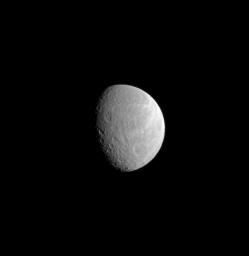
|
Ancient Crater on Wispy Rhea
- Click the image above for a larger view
- Full-Res JPEG (669 x 689) (11.8 kB)
- Full-Res TIFF (669 x 689) (461.6 kB)
Caption:
A wide crater dominates the lower right of this image while part of Rhea's brightly lit, wispy terrain can still be seen near the limb of the moon. Smaller craters are overprinted upon this crater, telling the story of an extremely old feature that has collected impacts over the eons.
Younger craters also have been collected on another of Rhea's large basins—Tirawa (see PIA08976 ).
North on Rhea (1528 kilometers, or 949 miles across) is up in this image. This view looks toward the Saturn facing-side of Rhea. The image was taken in visible light with the Cassini spacecraft narrow-angle camera on Aug. 27, 2008.The view was acquired at a distance of approximately 1.1 million kilometers (680,000 miles) from Rhea and at a Sun-Rhea-spacecraft, or phase, angle of 56 degrees. Image scale is 6 kilometers (4 miles) per pixel.
Background Info:
The Cassini-Huygens mission is a cooperative project of NASA, the European Space Agency and the Italian Space Agency. The Jet Propulsion Laboratory, a division of the California Institute of Technology in Pasadena, manages the mission for NASA's Science Mission Directorate, Washington, D.C. The Cassini orbiter and its two onboard cameras were designed, developed and assembled at JPL. The imaging operations center is based at the Space Science Institute in Boulder, Colo.
For more information about the Cassini-Huygens mission visit http://saturn.jpl.nasa.gov/ . The Cassini imaging team homepage is at http://ciclops.org .
Cataloging Keywords:
| Name | Value | Additional Values |
|---|---|---|
| Target | Rhea | Saturn |
| System | Saturn | |
| Target Type | Satellite | Planet |
| Mission | Cassini-Huygens | |
| Instrument Host | Cassini Orbiter | |
| Host Type | Orbiter | |
| Instrument | Imaging Science Subsystem (ISS) | |
| Detector | Narrow Angle Camera | |
| Extra Keywords | Crater, Grayscale, Impact, Visual | |
| Acquisition Date | ||
| Release Date | 2009-02-25 | |
| Date in Caption | 2008-08-27 | |
| Image Credit | NASA/JPL/Space Science Institute | |
| Source | photojournal.jpl.nasa.gov/catalog/PIA10586 | |
| Identifier | PIA10586 | |
